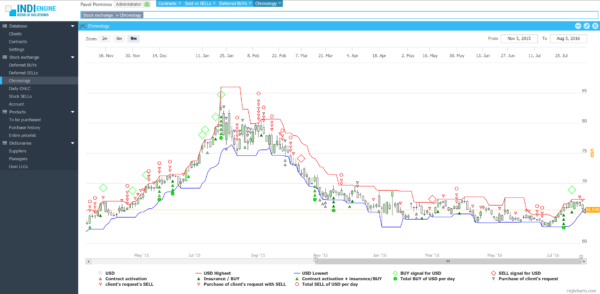Calculates and hedges risks arising from fluctuations in exchange rates for deferred deliveries of goods purchased in foreign currency with price fixing in rubles at the time contract’s conclusion; insures risks by buying currency directly on the Moscow Exchange via API access
To acquire a profit as planned, you have to make sure your expenses will be the same as you initially expected. If your expenses become higher/lower because the currency exchange rate becomes higher/lower but you prefer to keep the profit as planned – you need to hedge this risk.
How it works
You fill in info about your suppliers, their products that you’re going to sell, and your clients in the Dictionaries » Suppliers, Products » Entire Pricelist, and Database » Clients app sections respectively. For the products part, you will have to specify at what price and in what currency (!) each product is being supplied by its supplier. That currency may be either in local currency or foreign currency.
You create the contract in the Database » Contracts app section, specify the client, and create the sales plan for that contract in the Database » Contracts » Your contract » Specification – sale plan app section, selecting the products from the entire pricelist and specifying the price for each of them in your local currency, e.g. the price that you will be selling this product to your client for.
Once the contract has been signed – you activate the contract, so the date of signature will be used as a start point for calculation of State Bank currency rate volatility and calculation of the currency risk created by the volatility. Upon activation, app groups sale plan’s products by currencies that you’ll need to pay for them to your suppliers, calculates the summaries for each group related to foreign currencies, and do BUY operation on the currency exchange market. Your risks are now hedged.
After some time, your client sends you the request, at which point you create a new entry in the Database » Contracts » Your contract » Clients’ requests – sale fact app section and specify products and the quantities for them that client wants to get – in the Ordinary items app subsection. Once you’ve specified and checked them – change the client’s request entry Status to Closed.
Once you’ve changed the Client’s request entry’s Status to Closed – a number of new entries will appear in the Products » To be purchased app section, so you must go there and press the Purchase button to tell the app to calculate and SELL the volumes on the currency exchange market according to quantities requested by the client.
If your expenses grew higher than you expected due to currency exchange rates increasing – you can then compensate for the unexpected losses by withdrawing the profit that appears on your currency exchange account after the SELL operation performed by the app. If exchange rates fall lower, you should move the unexpected profit from you company bank account to you company currency exchange market account, to keep the zen
The use case described above is not the only possible use case. You can also use hedging even in the case that you simply know, that someday your company will need a certain amount of foreign currency, but for today’s exchange rate, or in the case that you need to hedge, for example, 50% of your contract’s foreign currency risks.
Yes, you can always hedge your contract by buying the required foreign currency amounts directly at any bank, but you’ll need to withdraw 100% of it’s cost from your business flow. The app allows you to withdraw only 10% of required foreign currency cost, but yields the same financial result on exchange rate difference that would occur if you were selling the currency back to your bank.


admin –
asdasd
admin –
asd